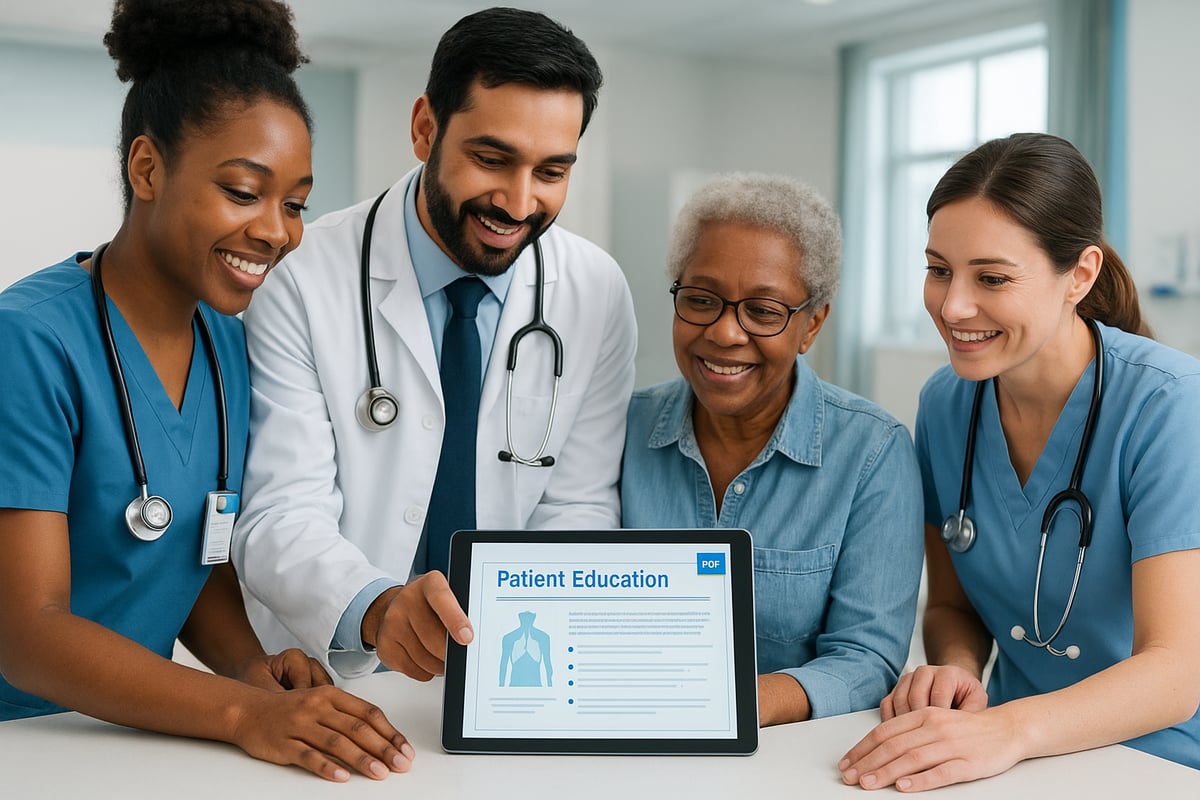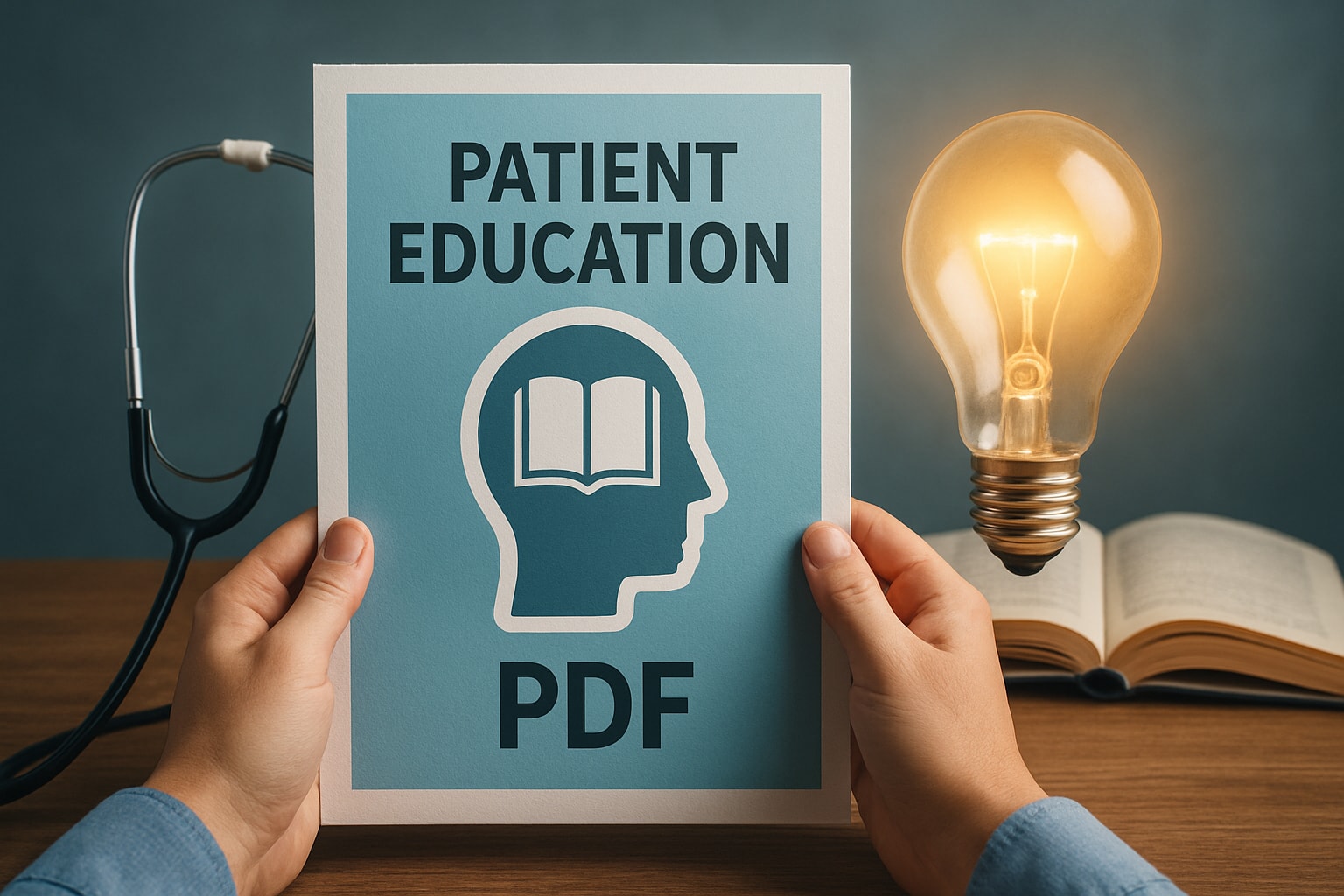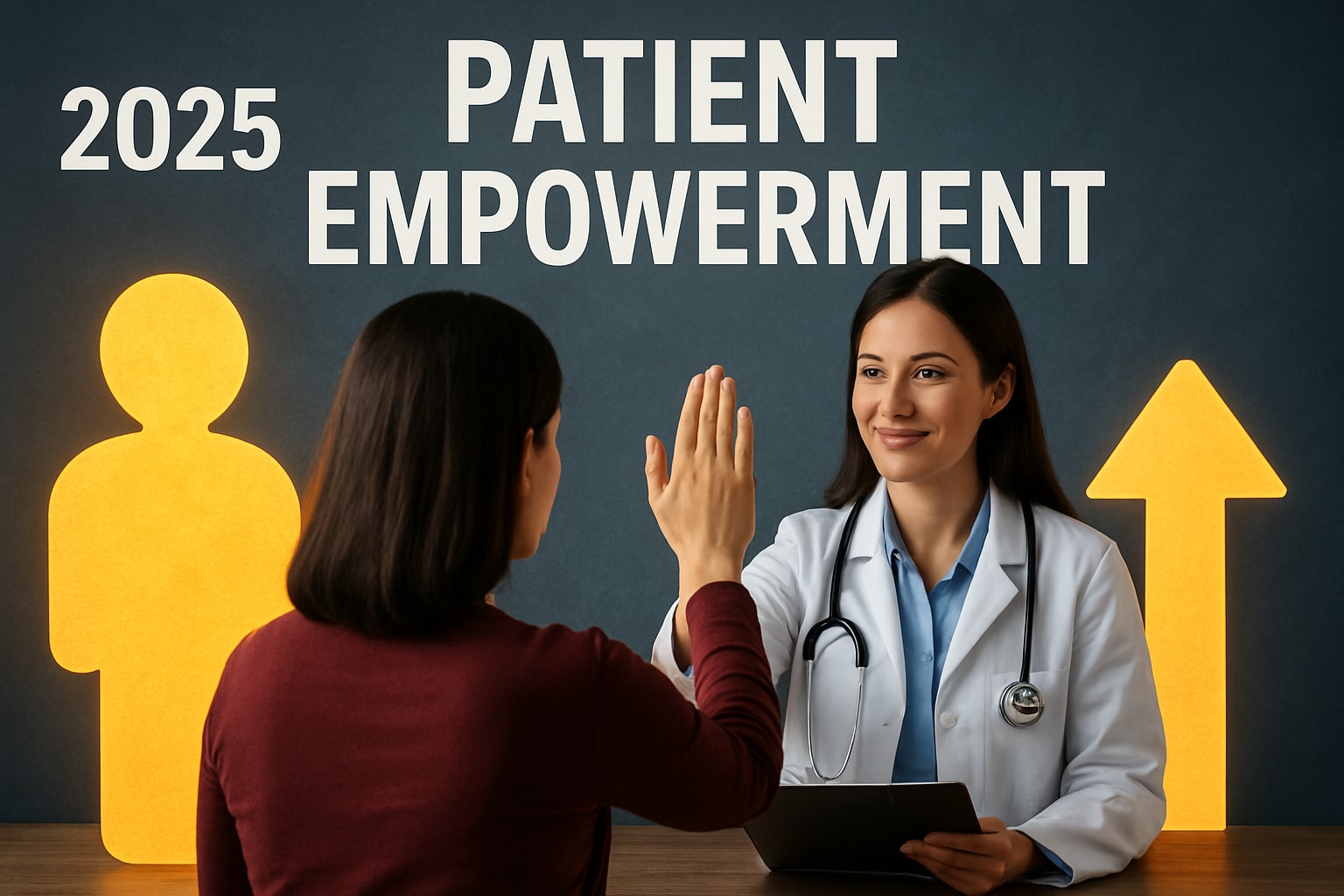In 2025, the healthcare landscape is rapidly evolving, with patient education pdf resources becoming a cornerstone for empowering individuals to take charge of their health. The demand for accessible, trustworthy educational materials has never been higher, and digital formats are now central to effective communication between patients and providers.
This comprehensive guide explores everything you need to know about patient education pdf in 2025. You will learn why these documents are essential, what core elements they should include, and how healthcare teams can develop and implement them successfully.
Discover the latest innovations that make patient education pdfs engaging and practical. Whether you are a patient, provider, or healthcare leader, this article offers actionable insights to help you enhance patient engagement and improve health outcomes.
The Importance of Patient Education in 2025
Patient education has never been more crucial in 2025. As healthcare continues to evolve, clear and accessible information empowers patients to actively participate in their own care. The patient education pdf is now a key resource, bridging knowledge gaps and supporting better outcomes.

The Evolving Role of Patient Education
In 2025, healthcare emphasizes patient-centered care and self-management. This shift is partly due to the rising prevalence of chronic diseases, which demand ongoing education and collaboration between patients and providers. Research consistently shows that effective patient education pdf materials lead to better health outcomes, higher satisfaction, and reduced provider liability.
Healthcare organizations now follow comprehensive guidelines, such as those outlined by the Health Care Education Association's Patient Education Guidelines, to ensure that patient education pdf content is clear, accurate, and patient-focused. These advancements underscore the evolving and essential role of patient education.
Benefits for Patients and Providers
The patient education pdf offers many benefits for both patients and healthcare providers. Patients who receive clear educational materials are more likely to adhere to treatment and medication regimens, improving their overall health.
They also gain a deeper understanding of their conditions, which can reduce complications and empower them to make informed decisions. Providers benefit from fewer hospital readmissions and unnecessary visits, as well as increased patient autonomy and more robust informed consent processes. The patient education pdf strengthens the provider-patient relationship and supports better health outcomes for all.
Impact on Healthcare Systems
Healthcare systems see significant value in the widespread use of patient education pdf resources. These materials are cost-effective, as they help decrease unnecessary resource utilization and lower the risk of malpractice.
By promoting preventive care and wellness, patient education pdfs support the continuity of care across different settings and providers. They also enable healthcare institutions to deliver consistent and standardized information, improving overall health outcomes. As a result, patient education pdf resources are now foundational tools that support both efficiency and quality in healthcare delivery.
Real-World Examples and Data
Data from community health nursing highlights the effectiveness of patient education pdf materials in practice. For example, patients who receive tailored educational content report higher satisfaction and compliance with care plans.
Case studies reveal that patient education pdf resources contribute to reduced complications and improved disease management, especially for chronic conditions like diabetes and hypertension. Competitor articles also stress the importance of self-management and healthier lifestyles, both of which are supported by accessible patient education pdf tools. These real-world examples demonstrate the practical impact of effective education materials.
Challenges and Barriers in 2025
Despite their benefits, patient education pdf resources face several challenges in 2025. Health literacy gaps remain a concern, as not all patients can easily understand medical information. The digital divide also persists, limiting access for some groups.
Cultural, linguistic, and socioeconomic barriers can further hinder the effectiveness of patient education pdf materials. Healthcare providers must also manage the risk of information overload, ensuring that content remains relevant and digestible. Overcoming these challenges requires ongoing effort and innovation in patient education.
Core Components of an Effective Patient Education PDF
A well-designed patient education pdf can transform the way patients understand and manage their health. To achieve this, each document must contain specific elements that ensure clarity, accessibility, engagement, and security. Let us explore the core components that make a patient education pdf both effective and impactful.

Essential Information to Include
The foundation of any patient education pdf lies in the accuracy and completeness of its content. Start by providing clear definitions of medical conditions, treatments, and procedures. Avoid ambiguity, as patients often rely on these documents to make important decisions.
Break down complex processes into step-by-step instructions for self-care and daily management. Visual aids such as diagrams, charts, and illustrations help explain difficult concepts and support various learning styles. These visuals can bridge gaps in understanding, especially for patients with lower health literacy.
Use tables to summarize key steps or to compare treatment options. For example, a table outlining medication schedules or symptom management strategies can make instructions more digestible. Every patient education pdf should focus on making information actionable and easy to follow.
Customization and Personalization
Personalization is crucial for ensuring that a patient education pdf resonates with its intended audience. Tailor content to the patient's age, cultural background, and literacy level. Recognize that children, adults, and seniors have different learning needs and preferences.
Incorporate patient-specific data, such as preferred language or relevant medical history, to enhance relevance. Use plain language throughout, steering clear of medical jargon that might confuse or overwhelm readers.
Provide examples and scenarios that reflect the patient's daily life. For instance, dietary recommendations should consider cultural food preferences. This approach not only improves comprehension but also encourages greater engagement with the patient education pdf.
Accessibility and Usability Features
An effective patient education pdf must be accessible to all users, including those with disabilities. Choose readable fonts and maintain a logical structure with clear headings and bullet points. Ensure that the layout is easy to navigate, with clickable links and a consistent format.
Offer the document in multiple languages and alternative formats when possible. This increases reach and ensures inclusivity for diverse patient populations. Compliance with accessibility standards, such as ADA and WCAG, is essential to remove barriers for those with visual or cognitive impairments.
Add alternative text for images to support screen readers. These features ensure that every patient can benefit from the patient education pdf, regardless of ability or background.
Evidence-Based and Up-to-Date Content
Trustworthy patient education pdfs are grounded in the latest clinical evidence. Incorporate current clinical guidelines and best practices to ensure accuracy. Regularly update the content to reflect new research findings, medications, or treatment recommendations.
Cite reputable sources transparently, allowing patients and providers to verify the information. This builds trust and encourages adherence to the guidance provided. A well-referenced patient education pdf demonstrates a commitment to quality and continuous improvement.
Include a revision history or date of last update on each document. This simple detail assures users that the information they are reading is current and reliable.
Interactive and Engaging Elements
To maximize learning, a patient education pdf should engage the reader actively. Integrate quizzes, checklists, and self-monitoring tools to reinforce key points. These interactive elements invite patients to test their understanding and track their progress.
Present case scenarios and frequently asked questions to address common concerns. Such features make the learning experience more relatable and memorable. Provide space for patients to note questions or feedback, encouraging ongoing dialogue with healthcare providers.
Interactive tools not only boost engagement but also empower patients to take a more active role in their care.
Security, Privacy, and Distribution
Protecting patient information is paramount in any digital patient education pdf. Ensure that personal data is never included unless absolutely necessary, and always use secure channels for sharing documents. Distribute PDFs through patient portals, encrypted email, or QR codes to maintain confidentiality.
Follow best practices for licensing and distribution to safeguard intellectual property and patient privacy. For more insights on secure sharing and proper licensing, see Licensing Digital Patient Education Materials.
Make the patient education pdf easy to access for both patients and caregivers. Clear instructions for downloading or printing the document can help bridge technological gaps. By prioritizing security and thoughtful distribution, you ensure that sensitive information stays protected while supporting effective patient education.
Step-by-Step Guide to Developing Patient Education PDFs
Creating an effective patient education pdf involves a systematic process that ensures materials are accurate, accessible, and impactful. By following a structured approach, healthcare professionals can deliver information that truly supports patient understanding and engagement.

Step 1: Needs Assessment and Audience Analysis
The foundation of any successful patient education pdf is a thorough needs assessment. Start by surveying patients to uncover gaps in knowledge and preferred learning styles. Consider cultural background, language, and health literacy to ensure materials are inclusive.
Engage the healthcare team in discussions about common patient questions and challenges. Gather direct feedback from patients to tailor the patient education pdf to their real-world concerns. This step helps align content with the audience’s readiness to learn, making the information more relevant and actionable.
Step 2: Content Planning and Structuring
With your audience defined, the next step is to outline the key topics for your patient education pdf. Identify learning objectives and organize content from basic to advanced concepts. This logical progression helps patients build understanding step by step.
Break information into manageable sections, using bullet points and headings for clarity. Ensure each topic relates to the overall goals of the patient education pdf. Planning ahead also allows for easy updates and revisions as new evidence emerges, keeping your materials current and effective.
Step 3: Writing and Designing the PDF
When writing your patient education pdf, use clear, concise language that avoids jargon. Visual aids such as charts, diagrams, and infographics can make complex topics easier to grasp. Design the layout with readable fonts, ample white space, and a logical flow.
For real-world inspiration, explore Free Patient Education Downloads to see best practices in action. Incorporate diverse images and examples that reflect the patient population. A well-designed patient education pdf not only informs but also engages and motivates patients to participate in their care.
Step 4: Review and Validation
Before distributing your patient education pdf, seek feedback from clinical experts and patient educators. A peer review process helps catch errors, ensure accuracy, and verify that content aligns with clinical guidelines.
Pilot test the patient education pdf with a small group of patients. Collect their feedback on clarity, relevance, and cultural sensitivity. Revise the document as needed to address concerns and strengthen its effectiveness. This validation step builds trust and credibility in your educational materials.
Step 5: Digital Accessibility and Compliance
Accessibility is essential for any patient education pdf. Follow guidelines like proper font size, color contrast, and organized headings to support users with visual or cognitive impairments. Add alternative text to all images so screen readers can interpret the content.
Ensure your patient education pdf complies with legal and institutional standards, such as ADA and WCAG. This makes your materials usable by all patients, regardless of their abilities or devices. Prioritizing accessibility demonstrates a commitment to equitable healthcare education.
Step 6: Distribution and Patient Engagement
Once your patient education pdf is finalized, plan for effective distribution. Use secure patient portals, email, or printed handouts to reach your audience. QR codes can also provide instant access to digital versions.
Train healthcare staff to introduce and explain the patient education pdf to patients. Encourage questions and active participation during patient encounters. Engaged patients are more likely to read, understand, and apply the information, leading to better health outcomes.
Step 7: Evaluation and Continuous Improvement
Ongoing evaluation is vital to maintaining the quality of your patient education pdf. Collect feedback from patients and healthcare providers through surveys or informal conversations. Assess knowledge retention, treatment adherence, and patient satisfaction as key metrics.
Regularly review the patient education pdf to incorporate new research, guidelines, or patient suggestions. This continuous improvement cycle ensures your materials remain relevant and effective in supporting patient self-management and informed decision-making.
Example Workflow: Community Health Nursing Case
Consider a community health nursing team developing a diabetes management patient education pdf. First, they assess learning needs by interviewing patients about daily challenges and cultural beliefs. Next, they plan content to address diet, medication, and symptom monitoring.
The team writes and designs the patient education pdf with simple language and culturally relevant visuals. After peer review and pilot testing, they ensure accessibility features are included. Distribution occurs through group teaching sessions and individual handouts. Finally, outcomes are monitored and the pdf is updated based on patient feedback and clinical results.
Best Practices for Implementing Patient Education PDFs in Healthcare Settings
Implementing patient education pdf resources effectively requires a coordinated approach across all levels of healthcare. By focusing on training, integration, inclusivity, and continuous improvement, healthcare organizations can maximize the impact of these materials.

Staff Training and Role of Healthcare Professionals
Training staff to use patient education pdf materials is essential for delivering consistent and effective education. Nurses and providers must be confident in teaching with digital resources.
Promoting relationship-centered care builds trust and encourages open communication. Techniques like motivational interviewing and the teach-back method ensure patients understand instructions and feel empowered. Ongoing professional development helps staff stay updated on new tools and strategies for patient education pdf implementation.
- Regular workshops and refreshers
- Peer mentoring and knowledge sharing
- Simulation-based learning
Training creates a supportive environment where staff can address patient concerns efficiently.
Integrating Education into the Care Process
To optimize outcomes, patient education pdf materials should be integrated at every stage of care. This includes the initial assessment, diagnosis, care planning, implementation, and evaluation.
Using these resources during discharge planning and follow-up appointments ensures patients leave with clear instructions and support. Documentation of education provided, including the use of a patient education pdf, is critical for continuity of care and legal compliance.
- Embed education in electronic health records
- Use checklists for education delivery
- Schedule follow-ups for reinforcement
Consistent integration helps standardize education and improves patient engagement across the continuum of care.
Addressing Cultural and Linguistic Diversity
A patient education pdf must reflect the diverse backgrounds of patients. Providing materials in multiple languages and accessible formats ensures comprehension.
Culturally relevant examples and visuals make content relatable and effective. Involving families and support networks strengthens understanding and encourages adherence to care plans.
- Translate materials into common community languages
- Use culturally appropriate images and scenarios
- Offer interpreter support when needed
Personalizing content in a patient education pdf helps close gaps in understanding and fosters trust.
Overcoming Common Barriers
Healthcare organizations often encounter barriers such as low literacy, sensory impairments, and technology gaps. Adapting patient education pdf resources to address these challenges is vital for equitable care.
Ensuring privacy and comfort during education sessions increases patient willingness to engage. Leveraging technology, such as telehealth or mobile devices, can extend reach to remote populations. For guidance on creating inclusive and accessible digital content, see A Guide to Accessible Digital Content.
- Simplify language and visuals
- Provide audio or video versions
- Use large print and high-contrast design
Removing barriers ensures every patient benefits from the patient education pdf, regardless of their circumstances.
Monitoring Effectiveness and Outcomes
Evaluating the impact of patient education pdf materials is crucial for ongoing improvement. Direct observation, oral questioning, and patient self-reporting are practical ways to assess understanding and retention.
Tracking patient compliance, health outcomes, and satisfaction provides valuable feedback. Adjusting strategies based on evaluation data ensures that the patient education pdf remains relevant and effective.
- Collect feedback from patients and providers
- Monitor readmission and complication rates
- Update materials regularly based on results
Continuous monitoring leads to higher quality education and better health outcomes for all patients.
Innovations and Future Trends in Patient Education PDFs
Healthcare is experiencing a rapid shift toward digital solutions, and the patient education pdf is at the forefront of this transformation. As technology advances, these documents are evolving to meet the changing needs of patients, providers, and healthcare systems. Below, explore the most significant innovations shaping the future of patient education pdf resources.
Digital Transformation and Smart PDFs
The patient education pdf is no longer just a static document. Today’s smart PDFs integrate with patient portals and electronic health records, making them easy to access and update. Interactive features, such as embedded videos and clickable elements, help patients engage with their care instructions.
Accessibility is also a top priority. Compliance with updated standards, such as the Revised 508 Standards and 255 Guidelines, ensures these PDFs are usable by everyone, including those with disabilities. QR codes are increasingly used to provide instant access to supplementary resources, making the patient education pdf a dynamic and inclusive tool.
Personalization Through AI and Data Analytics
Personalization is transforming the patient education pdf into a tailored learning experience. Advanced AI algorithms can analyze patient data to customize content, ensuring each document addresses the individual’s unique needs and preferences.
These smart PDFs may feature adaptive learning modules, offering real-time feedback as users progress. Predictive analytics can identify gaps in knowledge or emerging educational needs, prompting timely updates. By leveraging data, the patient education pdf becomes more relevant, engaging, and effective for every patient.
Gamification and Engagement Tools
To boost motivation and retention, many patient education pdfs now include gamification elements. Patients might encounter quizzes, earn badges, or track their progress through interactive checklists. These features make learning more engaging and encourage active participation.
Healthcare organizations report increased information retention when interactive elements are present. Real-world case studies highlight how gamification in a patient education pdf can lead to improved self-management and better health outcomes, especially in chronic disease care.
Expanding Access and Global Reach
Mobile-friendly patient education pdfs are bridging gaps in healthcare access. Designed for smartphones and tablets, these documents reach patients wherever they are, including rural or underserved communities. Partnerships with community organizations and telehealth platforms further extend their impact.
Efforts to bridge the digital divide are central to future development. By prioritizing accessibility, language diversity, and ease of use, the patient education pdf is poised to support equitable healthcare education worldwide.
Real-World Examples and Case Studies
Exploring how the patient education pdf is utilized in real healthcare environments reveals the tangible benefits and challenges of effective patient education. The following case studies highlight diverse settings, populations, and strategies that have shaped patient outcomes in 2025.
Hospital-Based Patient Education Initiatives
Many hospitals have adopted standardized patient education pdf resources to support post-surgical care. For example, one major healthcare system introduced a comprehensive pdf for cardiac surgery patients, detailing recovery steps, medication schedules, and warning signs.
This approach led to clear improvements in patient satisfaction and a measurable reduction in hospital readmissions. Providers noted that when patients received a well-structured patient education pdf before discharge, they felt more empowered and less anxious about managing care at home. Consistent use of these materials also supported staff in delivering uniform, evidence-based instructions.
Community Health Nursing and Chronic Disease Management
In community health settings, the patient education pdf plays a vital role in chronic disease management, especially for conditions like diabetes. Nurses developed tailored pdfs for rural populations, using simple language, visuals, and culturally relevant examples.
These pdfs improved patient understanding of self-monitoring, medication adherence, and dietary choices. According to How Nursing Students Use Patient Education Guides, such guides also enhance academic skills and clinical confidence among nursing students, further supporting patient outcomes. Regular updates and community feedback ensured the pdfs remained relevant and effective.
Pediatric and Geriatric Patient Education
Patient education pdf resources for children and older adults require special considerations. Pediatric pdfs often include engaging illustrations, age-appropriate explanations, and checklists for caregivers. For geriatric patients, content is simplified and formatted for readability, with larger fonts and clear instructions.
Family involvement is encouraged, ensuring that caregivers understand the information and can support adherence. These strategies have led to increased confidence among both patients and families, fostering better health management and communication with providers.
Lessons from Leading Health Organizations
National and international health organizations have set benchmarks for developing and evaluating patient education pdf materials. They emphasize data-driven content creation, regular outcome measurement, and adaptation based on patient needs.
Several agencies publish best practice guidelines, highlighting the importance of accessibility, personalization, and cultural competence. By following these standards and incorporating feedback, healthcare providers can ensure their patient education pdf resources remain effective and future-ready in an evolving healthcare landscape.





